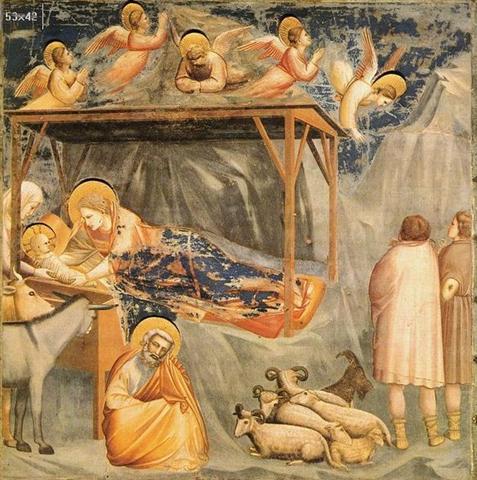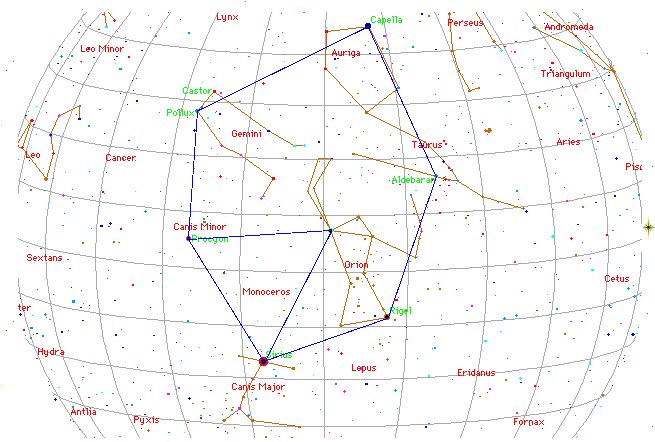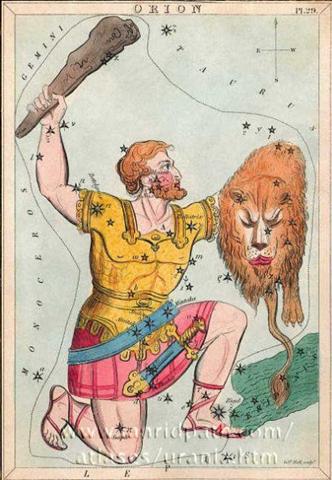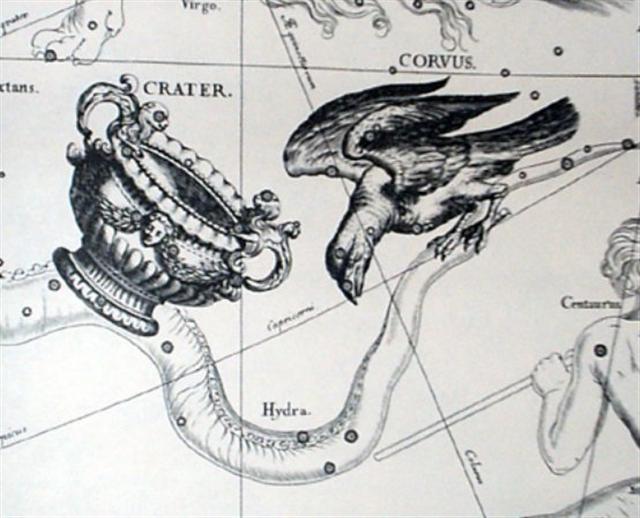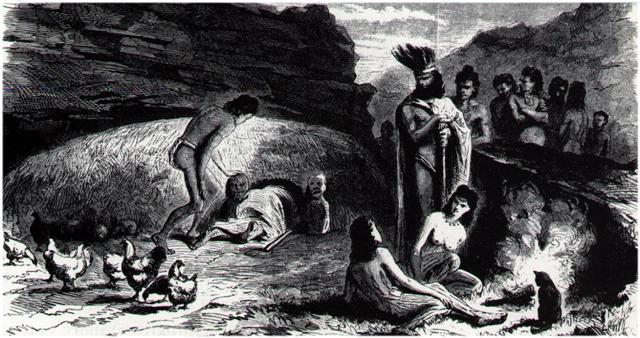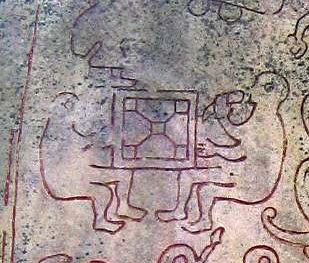The Winnowing Basket was also a Cradle - birth and death being only different aspects of the same phenomenon, viz. life. And we can compare with the place where the Full Moon was, viz. at (or at least close to) the right ascension line for 18h - 24h / 2 = 6h. If the Winnowing Basket and 18h represented death, then 6h ought to represent birth (the Cradle).
As I have suggested regarding the C text it probably was beginning where at the time of rongorongo the Full Moon was at Sirrah (the Navel of the Horse, α Andromedae), i.e. at the Topknot of Taranga where Maui was born. At the time of rongorongo Sirrah rose with the Sun at 0h (= March 21, 80, which was 364 / 4 days after the solstice in December 21).
By looking at the stars close to the Full Moon it would be possible to deduce where the Sun was (the nakshatra method for determining time). For people down on Easter Island 0h meant where the winter half of the year was beginning, but by observing the Full Moon it could be seen that north of the equator 0h meant where the winter half of the year was ending. So, when considering the glyphs at the beginning of side a on the G tablet - which presumably were attuned to MARCH 21 at the time of the Bull - the reader on Easter Island could have deduced where the Full Moon had been at the time of the Bull, viz. by using the nakshatra method in reverse so to say. For instance, when at the time of the Bull the Sun had reached OCTOBER 16, corresponding to 18h at the time of rongorongo, this place pointed at 6h as the place for the Full Moon, viz. right ascension day *91 = day 80 + 91 = 171 = June 20, which in turn corresponded to day 171 - 64 = 107 = APRIL 17 (*27) at the time of the Bull. However, the Bharani time-frame indicated the Full Moon had been in day 171 (June 20) - 41 = 130 ("May 10) with the Sun in day 353 (December 19) - 41 = day 312 ("November 8):
The Club wielded by Orion originated from ξ at his Right Hand - in contrast to the dead old lion hiding his left:
In the picture we can similarly see only the left front paw of the old lion, while his tail is hanging down into the Eridanus river. This image suggests Orion and Leo were the same - birth at Orion and death at Leo. ... The brutes of spring caused the downfall of both Captain Cook and Julius Caesar. We are close to the key myth of mankind, that which explains the regeneration of sun and of growth. Once at least some people kept the tradition living. I became interested in what really happened at March 15 and reopened Henrikson to find out: Caesar was forewarned of the threat by the prophet Spurinna, who told him that a great threat was coming at Idus Martiae or just before [i.e. at 3-14]. The day arrived and Caesar was still living, walking to his meeting with the Senate when he happened to encounter Spurinna and told him jokingly that he was still alive. Spurinna calmely answered that the day had yet not ended. The Romans divided their months in two parts and the dividing point was Idus, which in some way was connected with full moon. March 15 was the midpoint of March, which is close to spring equinox. The old agricultural year defined the beginning of the year to the time when sun returned, and it was connected with Mars ...
A beautiful little Rei glyph followed immediately after Ga1-29. And then we can subtract 29 (Mercury) - 25 (Saturn) = 4. Maybe this explains why Aldebaran - at the foot of which was tattooing - had not been placed at the beginning of side a of the G tablet. When, at the time of rongorongo, the Sun reached Antares (Rehua) it meant he had come down from the northern hemisphere in order to create summer down in the south. Anciently, at the time of the Bull, the Canoe of the Sun had been turned upside down in SEPTEMBER 22, i.e. 84 days after the dry place at Alkes (where the sweet water had run down into the Abyss).
The Babylonian idea of the night sky was that of an overturned boat:
... It is certainly true that the exterior form of the hare paenga, when the superstructure and thatch are intact, resembles an overturned boat, with the form established by the foundation. However, it is equally true (and perhaps equally important) that the configuration of the foundation is otherwise most like the Rapa Nui vulva design called komari. The komari is the quintessential female symbol which is everywhere prominent in Rapa Nui art, often carved in rock and wood, incised on human crania, and painted on the human body. In the hare paenga foundation form, the komari is cut in stone and embedded in the earth, the cosmologically female realm. Spanning above, over and virtually into this komari foundation is the ridgepole 'backbone' and curved rafter 'ribs' of what I surmise to be a symbolically male form. In short, we have a shelter which may be metaphorically understood as 'the sky father enclosing his progeny as he embraces the earth'. Those progeny entered and departed this male/female, earth/sky form through a low, dark tunnel which may be logically compared to the birth canal. This postulated symbolism does not, of course, negate the 'overturned boat' comparison, since Polynesian canoes were often likened to the bodies of great ancestors or to Tane as First Man. The canoe which transported the first exploratory voyage to Rapa Nui was said to have been called The Living Wood, a reference to Tane. Indeed, it is likely that the 'overturned boat' concept and its relationship to home, hearth and lineage, which is so graphically visible, was commonly understood (hence its retention in the oral literature), while the more esoteric godly connections, perhaps along the lines of those explored here, were known only by spiritual leaders ...
But instead of moving into the night the Sun ought to have returned to his beginning, viz. firstly to Aldebaran and from there flying 25 (adopted rat) nights ahead (past the 'tent-peg' in Orion) in order to reach Gemini and a new Land.
... What happens after (or happened, or will happen sometime, for this myth is written in the future tense), is told in the Völuspa, but it is also amplified in Snorri's Gylfaginning (53), a tale of a strange encounter of King Gylfi with the Aesir themselves, disguised as men, who do not reveal their identity but are willing to answer questions: 'What happens when the whole world has burned up, the gods are dead, and all of mankind is gone? You have said earlier, that each human being would go on living in this or that world.' So it is, goes the answer, there are several worlds for the good and the bad. Then Gylfi asks: 'Shall any gods be alive, and shall there be something of earth and heaven?' And the answer is: 'The earth rises up from the sea again, and is green and beautiful and things grow without sowing. Vidar and Vali are alive, for neither the sea nor the flames of Surt have hurt them and they dwell on the Eddyfield, where once stood Asgard. There come also the sons of Thor, Modi and Magni, and bring along his hammer. There come also Balder and Hoder from the other world. All sit down and converse together. They rehearse their runes and talk of events of old days. Then they find in the grass the golden tablets that the Aesir once played with. Two children of men will also be found safe from the great flames of Surt. Their names, Lif and Lifthrasir, and they feed on the morning dew and from this human pair will come a great population which will fill the earth. And strange to say, the sun, before being devoured by Fenrir, will have borne a daughter, no less beautiful and going the same ways as her mother.' Then, all at once, concludes Snorri's tale wryly, a thunderous cracking was heard from all sides, and when the King looked again, he found himself on the open plain and the great hall had vanished ...
|
||||||||||||||||||||||||||||||||||||||||||||||||||||||||||||||||||||||||||||||||||||||||||||||||||||
